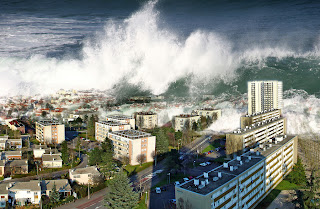A huge number of people believe that global warming caused the recent tsunamis that wiped out a large part of Japan. However, in our opinion, that is not possible and based on the things that we have learned we knew that this is not possible. In any perspective that we tried looking at, it definitely has nothing to do with the tsunamis. To learn more about this subject, let us dig in deeper in topics concerning these things. We shall briefly discuss what causes tsunamis and global warming as well as its effects. If you are interested, read more.
Global warming could not possibly be the cause of these tsunamis. We based it on the following summaries of facts:
1. Earthquakes cause tsunamis. Earthquakes that take place on water bodies could form a stronger tsunami like the one in Japan. In addition, underwater volcanic eruptions could also create tsunamis.
2. Too much carbon gases in the atmosphere, which causes the global temperature to shoot up causes global warming. It has no direct relationship with earthquakes and volcanic eruptions.
We did a little research of our own and came up with these two conclusions. These conclusions came from the number of facts that we gathered from legitimate sources. However, as we were scanning through various resources, we came by a piece of article that contains a theory that global warming just might have something to do with tsunamis. Again, it is just a theory. Here it is:
Researcher Gary McMurty of University of Hawaii thinks that mega tsunamis happen often happens more or less once every hundred thousand years. They based this on a discovery that found marine fossils on top of a volcano named Kohala in Hawaii. The volcano is around several kilometers high. Anyone would wonder why a fossil of marine nature would end up there.
A tsunami that is about a quarter of a mile high once destroyed ancient Hawaii, hundreds of thousands of years ago, leaving marine fossils on volcano tops. They also are investigating and re - examining some evidences that they found supporting a mega tsunami that was presumed to have occurred around 420,000 years ago in the Atlantic, specifically in Bermuda. They came up with a mini - conclusion that these mega tsunamis tend to occur when the ocean level is high. We currently have a high ocean water level because of global warming.
However, this remains a theory, which could be wrong or right. What is important is that we all work for the better. Let us join the campaign against air pollution and global warming.
Global warming could not possibly be the cause of these tsunamis. We based it on the following summaries of facts:
1. Earthquakes cause tsunamis. Earthquakes that take place on water bodies could form a stronger tsunami like the one in Japan. In addition, underwater volcanic eruptions could also create tsunamis.
2. Too much carbon gases in the atmosphere, which causes the global temperature to shoot up causes global warming. It has no direct relationship with earthquakes and volcanic eruptions.
We did a little research of our own and came up with these two conclusions. These conclusions came from the number of facts that we gathered from legitimate sources. However, as we were scanning through various resources, we came by a piece of article that contains a theory that global warming just might have something to do with tsunamis. Again, it is just a theory. Here it is:
Researcher Gary McMurty of University of Hawaii thinks that mega tsunamis happen often happens more or less once every hundred thousand years. They based this on a discovery that found marine fossils on top of a volcano named Kohala in Hawaii. The volcano is around several kilometers high. Anyone would wonder why a fossil of marine nature would end up there.
A tsunami that is about a quarter of a mile high once destroyed ancient Hawaii, hundreds of thousands of years ago, leaving marine fossils on volcano tops. They also are investigating and re - examining some evidences that they found supporting a mega tsunami that was presumed to have occurred around 420,000 years ago in the Atlantic, specifically in Bermuda. They came up with a mini - conclusion that these mega tsunamis tend to occur when the ocean level is high. We currently have a high ocean water level because of global warming.
However, this remains a theory, which could be wrong or right. What is important is that we all work for the better. Let us join the campaign against air pollution and global warming.











